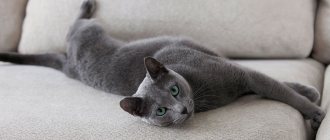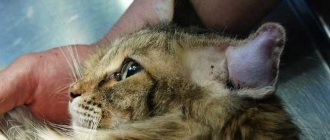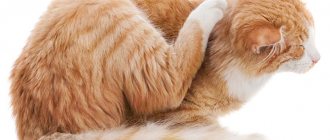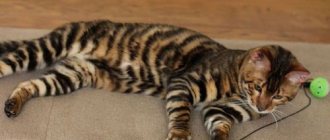Symptoms of illness in a cat are easy to miss, since the pet will not say in words about its suffering. Therefore, the owner must always be on alert in order to provide urgent assistance in time and show the pet to the doctor. It remains to figure out how to understand that the cat is sick.
How can you tell if your cat is sick?
Cat diseases
The list of diseases that affect cats is quite extensive. Some of them are hidden and develop over years - for example, viral leukemia. Others have pronounced symptoms and appear immediately after damage to the body - like poisoning with toxic substances.
Table 1. Diseases in cats.
| Body system, nature of the disease | Names of the disease |
| Infectious | plague, viral leukemia, respiratory infections, Aujeszky's disease, rabies, helminthic infestations, flea infestation, herpes virus |
| Cardiovascular | atherosclerosis, myocarditis, endocarditis, pericarditis, myocardosis |
| Respiratory | runny nose, bronchitis, laryngitis, pneumonia |
| Gastrointestinal tract | esophageal obstruction, gastric ulcer, gastritis, enteritis |
| Leather | scabies, dermatitis, pyodermatitis |
| Muscular (rare) | myositis |
| Teeth | tartar |
| Joints | arthritis and arthrosis |
| Eyes | conjunctivitis, blepharitis, corneal ulcer |
| Ears | ear mites (otodectosis) |
| Immune | anaphylactic shock, allergic reactions |
| Genitourinary system | nephritis, pyelonephritis, nephrosis, urocystitis |
These are just some of the diseases that pets face. However, almost all of them have manifestations that a caring breeder will always notice.
The list of cat diseases is quite long.
Symptoms of pain syndrome
The cat is a predator. Therefore, she heroically endures and hides the pain. In the wild, this is necessary for survival. Therefore, the owner does not always immediately notice that the pet needs help. At the same time, pain accompanies many diseases, including deadly ones.
Attention! In most cats, signs of pain are easier to spot when she thinks she is not being observed. To notice the true state of a cat, it is enough to pretend that they are not paying attention to it, but at the same time observe the behavior out of the corner of your eye.
At the first sign of pain, the pupils of the eyes dilate
The following symptoms will tell you that your cat is feeling unwell:
- pupils dilated;
- sociable individuals stop contacting the owner, and unsociable ones stay even further away;
- the pet avoids touching, especially with sharp and acute pain;
- unreasonable aggression towards a person or other living creature manifests itself (if this is not a character trait);
- the animal bites the sore spot or licks it;
- lethargic, depressed state;
- eye closed by the third eyelid;
- the cat doesn't jump like before;
- if there is pain in the oral cavity, he may try to get his paw into it;
- if there is a problem with the ears, he tilts his head to the side from which he feels pain;
- tense posture, with an arched spine, in a lying position - with a hunched back and tucked paws.
Aggression occurs due to pain
Can a person infect their cat with coronavirus?
Apparently, yes. Since COVID-19 was contracted by domestic cats that came into contact with sick owners, transmission of the virus most likely occurred from person to animal. The BBC reported a case of infection of the tiger Nadya at the New York Zoo - in all likelihood, she caught the virus from a staff member. The Center for Disease Control and Prevention in the United States recommends that patients with coronavirus limit contact with pets to avoid infecting them. Chinese doctors also give similar recommendations. At the same time, emphasizing that the disease is not fatal for cats.
Murzik wants to go for a walk! How to walk cats and crabs during quarantine Read more
Behavior of cats when sick
You can tell if your cat is feeling unwell by his behavior. Sick animals change their life rhythms, habits and habits.
It is necessary to control the following processes:
- Duration of sleep and activity. Sick animals sleep more than usual. Drowsiness occurs in many diseases, and it should alert the owner.
- Using the tray . With some pathologies of the urinary system (for example, urolithiasis), animals either do not visit the toilet at all, or go there more often, but without results.
- Aggression . If this behavior is not typical for a cat, then this may indicate stress or pain.
- Lack of personal hygiene . The animal stops grooming itself, which is why it looks untidy.
Sick cat sleeps a lot
How can you tell if your cat is feeling pain?
If a cat has obvious injuries or surgical incisions, then we can reasonably assume that she is in pain. Although the signs may be subtle, careful and regular monitoring of your cat will indicate that she is in frequent pain. The cat may stop climbing, avoiding the window sills or the back of the sofa. A cat may also decide that stairs are too difficult and will only stay on one specific level of the house.
Some cats that are in pain may sleep longer than usual, while others may become restless because they are unable to find a comfortable lying position. A cat who has started walking past the litter box may actually just feel pain and avoid it if it means jumping.
Keep in mind that arthritis pain is quite common in older cats, but it can manifest differently depending on the part of the body affected. Before visiting your veterinarian, observe your cat to let him know exactly what changes in behavior you see.
Additional symptoms and signs that your cat may be in pain include:
- Resistance to caresses and other physical contact
- Avoidance of family events and activities
- Aggression when approached or caressed
- Decreasing self-care or increasing grooming in certain parts of the body
- Lameness or stiff gait
- Unexpected reactions when touched
- Changes in behavior
Character of bowel movements
With diseases of the digestive system, the stool becomes too liquid or, on the contrary, constipation occurs. There may be traces of blood in the feces.
In case of kidney or bladder diseases, the same happens with urine. It may acquire an unpleasant odor and be very dark and thick. Going to the toilet becomes more frequent or too infrequent. When a cat is about to urinate, it sits down for a long time and digs into the litter with its paws. In this case, you need to look in the tray to see if there is liquid there. If treatment is not taken, the animal may die within 2–3 days.
Posture when urinating in a healthy and sick cat
Body temperature
One of the most important indicators of health is body temperature. For adults, the norm is 38–39.0° C, for small kittens – 36.9° C. The temperature is measured by placing a thermometer in the ear canal or rectum. You can suspect a fever by the fact that the cat tries to retire, it becomes lethargic or apathetic, its appetite decreases, and sometimes it vomits.
Measuring a cat's temperature through the anus
Attention! Not only high, but also low body temperature, which is characterized by almost the same symptoms, is dangerous.
Measuring a cat's temperature through the ear canal
Video - How to measure a cat's body temperature
Let's name 6 signs of a healthy cat:
- your cat is cheerful and alert;
- the cat is not disheveled, has smooth fur, and takes diligent care of its coat;
- A healthy cat has an excellent appetite;
- she has a wet, cold nose; only during this time can her nose be warm and dry;
- the cat has a normal temperature;
- the cat does not hide from you and does not seek privacy.
Cat health is good if cats are active and mobile. In addition, body temperature, pulse and breathing rate are important criteria for assessing a cat’s condition.
The breathing rate can be determined by the movements of the chest, or the wings of the cat's nose. A healthy cat should have a respiratory rate of 20 to 30 breaths per minute.
Of course, the health of a cat worries any owner, especially if his cat is purebred and gentle. Outbred cats have strong immunity and therefore get sick less often. Any disease has its own cause, as well as a hidden (incubation) period of development. Most signs of infectious diseases appear after the incubation period.
Respiratory rate, shortness of breath, cough
Some owners may notice that the cat is breathing frequently and heavily even without exercise. Breathing disorders in cats are observed due to respiratory diseases - rhinitis, laryngitis.
Cat cough
In some pathologies, this is a health-threatening condition, especially if it occurs suddenly. Cats, like people, can have severe allergic reactions and asthma. Then it is necessary to immediately provide first aid, because the minutes count. Problems can also be caused by physical injuries, obstruction of the respiratory tract, bronchitis and pneumonia.
Video - How asthma manifests itself in a cat
Nausea, vomiting
For some cats, regurgitation is a normal phenomenon. This is how they get rid of fur in the body. Another probable cause can be determined by the smell, color and nature of the vomit:
- yellow, egg yolk color - gastrointestinal diseases;
- dirty green with a bad odor, especially with diarrhea - most likely an infection;
- the presence of blood - internal bleeding, neoplasms in the gastrointestinal tract, damage in the oral cavity or pharynx (if the shade is scarlet);
- foamy - stomach diseases;
- mucous membranes - stomach diseases, helminthic infestations;
- with the smell of feces - intestinal obstruction, peritonitis (inflammation of the peritoneum).
If vomiting occurs, it is necessary to exclude the possibility of poisoning.
Salivation
One of the symptoms that should not be ignored is drooling. It usually accompanies vomiting. However, this is how rabies can make itself felt.
Attention! This disease has no cure. If the diagnosis is confirmed, the cats are immediately euthanized. They do this as soon as possible, since the bite of an infected animal is dangerous for humans and other pets.
If you are drooling, you should also contact the clinic because your pet may have dental problems, gum disease, or tumors. This phenomenon can also be caused by bones stuck in the mouth or insect bites.
Video - Rabies in cats
Treats disease or prevents it?
Everyone knows perfectly well that treating any disease is more difficult than preventing it. We are responsible for those who are close to us. Therefore, to sense something wrong in time, to sense someone else’s pain, and to provide all possible help is a very important condition of balance that is often violated by a person.
It is important to be able to provide assistance, eliminate errors and obstacles, and add something vital. These simple laws are feasible only if there is a spiritual connection between living beings.
You can call it Love or Friendship. It doesn't matter. The main thing is not to lose it, because the health of cats is in human hands and our pets are dependent on us. Even ordinary attention to the animal will allow you to feel the beginnings of the disease at the early stage of a minor ailment.
This condition is most often reversible, you can change and do something, find and eliminate the cause, preventing the development of serious damage to the body.
The cat is a very difficult patient.
Distrustful by its nature, especially towards people, a cat qualifies any alarming action towards itself as nothing less than an infringement of its interests, therefore it is important not to forget that with its claws and teeth it is able to reach absolutely any part of its flexible body.
Of course, and not only to your own. Actively protecting itself from unpleasant procedures, a cat can seriously injure its caring “doctor” with its claws.
Discharge in cats
Discharge from the eyes, nose, and genitals is also a serious reason to take a closer look at your pet.
From the nose
Secretion from the nasal passages is not normal. This disorder is observed in various viral infections and parasites (chlamydia, toxoplasma). Yellow thick pus signals dangerous pathologies. Abundant transparent discharge appears due to allergies or due to foreign objects entering the nose.
Purulent runny nose
From the eyes
Discharge from the organ of vision can be purulent (white, yellow, greenish), brown, or transparent. This is how diseases of infectious and non-infectious origin make themselves felt - for example, allergies, conjunctivitis, viruses.
Conjunctivitis in a cat
From a cat's vagina
Discharge in cats occurs during pregnancy and estrus, and this is considered normal. But even then it is necessary to take a closer look at them and visually examine the color and consistency. If there is pus or blood in them, then the development of pyometra, vaginitis, and tumors of the genital organs is likely.
Vaginal discharge
From a cat's penis
In cats, a small amount of smegma, or lubricant, is allowed. The secretion accumulates near the preputial opening. However, the purulent, bloody nature of the flowing fluids indicates pathology of the foreskin, diseases of the urethra, prostate gland and other problems.
Discharge from the penis
Treatment at home: what medications can be given?
There are no special medications to treat colds in cats. Veterinarians recommend treating the disease with drugs that boost immunity and relieve symptoms. During therapy, the pet needs to be provided with comfortable living conditions, proper nutrition and rest.
Antibiotics
Colds in cats are treated with antibiotics when bacterial infections occur. Drugs must be selected with caution. Not only the recovery, but also the life of the pet depends on this. The most commonly prescribed medications for cats are:
- oxytetracycline;
- gentamicin;
- amoxicillin;
- chloramphenicol;
- kanamycin.
It is important to correctly calculate the dose of the drug, which depends on the weight, age and general condition of the cat’s body. For colds in cats, treatment at home involves following the administration regimen drawn up by the doctor. Otherwise, the drug is ineffective. The course of antibacterial therapy lasts 7-10 days. You should not interrupt treatment, even if the symptoms disappear after 3-4 days. If you refuse further administration of antibiotics, the infection may become chronic.
Injections
Both antibiotics and immunostimulating agents are injected. The administration of vitamins has a positive effect on the cat's condition. If the cold is severe, the animal can be treated with interferon. The product has a high price and has a number of side effects. It can be replaced with immunoglobulins - antibodies obtained from a recovered animal. They act only in the first days of illness. It is recommended to give injections to your cat at a veterinary clinic.
Nasal rinsing
The procedure helps clear the nasal passages of mucus secretions and restore breathing. For this purpose the following drugs are used:
- 2% zinc sulfate solution;
- 3% boric acid;
- 0.5% tannin solution;
- a mixture of adrenaline and novocaine.
A small amount of liquid is drawn into a pipette or syringe without a needle. The animal is placed on its side, holding its head. The medicine is injected into the nasal passage and the animal is allowed to lie down. After washing, you can drip a mixture of 1% methanol and fish oil. This remedy softens the mucous membranes, eliminating signs of irritation and inflammation.
Use of human medicines
In treating a cat, you can use some of the remedies used to treat colds in humans. Derinat and Nazivin drops help to cope with a runny nose. The recommended single dose for an adult cat is 1 drop. The use of some medications from a human medicine cabinet can be fatal to a pet. Antipyretics based on paracetamol and aspirin are toxic to cats. In addition, due to the small weight of the animal, it can be difficult to calculate and obtain the required dose of the drug.
Condition of coat and skin
Studying the condition of the skin of animals will reveal a hidden threat. So, cats get acne, especially Sphynx cats. A dermatological disease develops with increased production of sebum. Inflammation may indicate stress or lack of proper hygiene.
Acne in a Sphynx cat
The condition of the animal's fur worsens due to parasitic infections - ticks, fleas. Sick, overweight cats are not always able to take care of themselves. Therefore, their fur becomes dull, matted, and matted. Often, dandruff similar to human dandruff appears on the skin of an animal. It has both external and internal causes: fungus, burns, dry air in the apartment or organ diseases, stress, vitamin deficiency and even allergies.
Causes of dandruff in cats - from stress to gastrointestinal problems
Too dry skin in a cat is the result of a lack of moisture in the body. There is a simple dehydration test. You need to grab the fold of skin between the shoulder blades. If it does not smooth out for a long time, then the body lacks moisture.
Constant thirst
Caring owners always monitor the amount they drink and eat. Thirst increases when switching to dry food, pregnancy, increased physical activity, high ambient temperatures, due to diuretic products in the diet.
However, this is a reason to be wary: this is how diabetes mellitus can make itself felt. When taking certain medications and due to stress, thirst also increases.
Constant thirst in a cat accompanies diabetes mellitus
Body mass
Many cat owners are amused when the cat is large and “in body”. But excess weight is harmful to animals as well as to people, since it causes problems with the musculoskeletal system, heart, and blood vessels.
Specific body weight indicators depend on the breed. The following signs indicate excess weight:
- it is difficult to feel the ribs and spine;
- the waist is invisible;
- In the area of the sternum, on the back, when palpated, fat is felt.
With obesity, these signs intensify, in addition, the volume in the abdominal area greatly increases.
Extra pounds in felines occur as a result of stress, hormonal disorders, overeating and poor nutrition. This is also typical for castrated animals.
Preventing excess weight for spayed or neutered pets
Overweight cat
Lack of weight in a cat is also dangerous. Thinness occurs due to helminthic infestations, cancer, and digestive problems. The fact that a cat has lost a lot of weight can be determined visually:
- there is no fat layer at all in the chest area;
- the muscles are almost invisible;
- In smooth-haired cats, pelvic bones, ribs and other parts of the skeleton are visible under the skin.
Underweight cat
Signs of disease in kittens
Some people specifically select sick animals to give them love and care. But when it comes to breeders who want to engage in breeding, it is extremely important that the individual is healthy.
The following signs indicate illness:
- lameness;
- tilting the head to the side or forward;
- purulent, watery eyes, swelling and redness of the eyelids;
Watery eyes are a sign of unhealthy kittens
- open nictitating membrane (third eyelid), squint;
- inflammatory process on the skin of the nostrils, discharge from the nasal passages;
- irritated skin of the ears, the presence of gray or brown crumbs in them;
- swelling, redness or poverty of the gums, ulcers on the surface of the oral mucosa;
- lack of activity and playfulness inherent in cats of this age;
- bloating, hollowness, pain in the abdomen;
- dullness of the coat, general unkemptness, bald patches;
- symptoms of gastrointestinal disorders - vomiting, loose stools;
- respiratory phenomena - coughing, sneezing.
Video - How to choose a healthy kitten
How to recognize?
Signs of infectious diseases
Diseases of a viral nature are characterized by the appearance of ulcers on the animal’s body.
Veterinarians classify such diseases in cats into viral, bacterial and fungal, and when infected with different pathogenic microorganisms, a different therapeutic approach is required. The table shows the main types of infectious diseases that are often diagnosed in cats and the characteristic clinical picture.
| Pathogens | Pathologies | Symptoms |
| Viruses | Infectious panleukopenia or feline distemper, calcivirosis, coronavirus and rabies | Feverish state |
| Frequent vomiting and nausea | ||
| Problems with stool, causing the cat to experience diarrhea | ||
| The appearance of ulcerative wounds on the skin | ||
| Bacteria | Infectious anemia and salmonella infection | The main symptom of the disease is fever |
| Lethargy and apathy | ||
| Sick cat refuses to eat | ||
| Pale mucous membranes of the mouth | ||
| Mucus discharge from the nasal passages | ||
| Fungi | Cryptococcosis, candidiasis, histoplasmosis | Whitish and other plaque on mucous membranes |
| Weakness and decreased activity | ||
| Reluctance to eat | ||
| Skin ulcers |
Allergic reaction
With this pathology, pets may suffer from eczema.
Every owner should know what allergies look like in a cat, since such a disorder is common in pets. You can recognize the disease by the following symptoms:
- skin itching;
- redness of the epidermis;
- frequent scratching;
- hair loss and deterioration of its condition;
- the appearance of eczema, papules and blisters;
- discharge from the nasal passages;
- diarrhea and vomiting;
- ear inflammation.
Parasite infestation
If the cat is not feeling well, then perhaps he has recently had helminths or small parasites are still observed in his body. As a rule, owners learn about helminthiasis in cats by a number of symptoms:
If parasites live in the animal’s body, a cough may indicate their presence.
- Digestive system disorders: frequent vomiting;
- constipation and/or diarrhea;
- reluctance to eat.
If the cat is sick and parasite activity is observed, then it is necessary to treat the pet as soon as possible. If nothing is done, the animal will develop signs of intoxication and paralysis of the hind legs is possible.
Congenital diseases
When the disease develops, fluffies prefer to hide from everyone.
If a cat experiences alarming symptoms, this may indicate genetic pathologies. Disorders can affect the nervous system, kidneys, liver, heart, blood vessels, eyes and other internal organs. Owners should be aware that there are some pet breeds that have a higher risk of congenital abnormalities. At the same time, clinical symptoms of such diseases usually appear in a kitten in the first days of life or several months later. As soon as the owners notice that the cat has a stomach ache, he often hides, his general condition is greatly deteriorating and other alarming signs are observed, they should immediately contact a veterinarian.
Manifestation of oncology
The main sign of the disease is the appearance of compaction or swelling in the affected area. As soon as the owners have discovered a similar sign in the cat, it is worth examining the pet at a veterinary clinic. A special feature of oncology is its ability to remain silent for a long time and proceed in a latent form. As the tumor grows, the cat experiences the following clinical picture:
Such a dangerous disease very often makes itself felt by the appearance of subcutaneous nodes.
- formation of subcutaneous nodes;
- change in eyes;
- vomiting and nausea;
- causeless bleeding;
- wounds that do not heal for a long time.
Symptoms of other diseases
The pet’s clinical picture may be mild for some time even after recovery, in which case treatment must be continued. If the owners notice that it is painful for the cat to swallow and that sores have appeared in his mouth, this may indicate pathologies of the oral cavity. Against the background of other diseases of the kidneys, gastrointestinal tract and other organs, the pet may show aggression towards its owners and often try to retire. Many animal disorders are accompanied by anxiety and sudden changes in mood. Sick or recently recovered cats may avoid contact with a person, and when he tries to pet or pick her up, she meows or hisses loudly. If at least a few alarming symptoms are detected, it is recommended to surround the cat with love and care, and do not delay a visit to the veterinarian.
Prevention of diseases in cats
Preventing illnesses in cats is not that difficult. One of the mandatory preventive measures is periodic visits to the veterinarian. It is believed that the examination should be carried out once every quarter or at least every six months.
The cat's diet should be balanced, with sufficient vitamins and minerals. Vitamins of group B, A, C, E, D, K are necessary. But it is advisable that they enter the body with food.
Important! Hypervitaminosis is no less harmful. There is no need to buy vitamins for your animal every time you visit a pet store. A deficiency of vitamins is also fraught with disorders in the body. Only a specialist should prescribe vitamin and mineral complexes.
Some symptoms require your cat to be seen by a doctor immediately.
You should immediately contact the clinic if you have the following symptoms:
- change in habits, especially if the cat is taken outside or allowed to walk on its own;
- traces of bites from another animal;
- seals on the body;
- the cat refuses food and drink for several days;
- signs of poisoning;
- body temperature has changed sharply;
- there is a suspicion of injury.
It is advisable for animals that go out on their own to purchase special flea collars.
Flea collar for a kitten
If any deviations in the behavior or condition of the cat appear, it is better to immediately show it to a doctor. After all, they often turn to a specialist in the final stages, when nothing can be done.
The recommendations will help cat lovers pay attention to homeless animals that also need human help and participation. This will also help to identify individuals infected with dangerous infections, such as rabies, and take preventive measures in time.
How to prevent the development of the disease in cats.
Many owners underestimate the importance of a routine check-up with a veterinarian. Many owners do not show their purring to the veterinarian for several years. Some people do not want to subject their cats to the stress of a veterinary visit, as some cats become very anxious or even aggressive at the vet. However, to solve this problem, you can invite a veterinarian to your home (Many cats feel better in a familiar environment) or find a clinic in which the environment will be less stressful for your cat.
Annual veterinary examinations are required for cats. These visits give your veterinarian an opportunity to examine your cat and catch problems in their infancy before your cat actually gets sick. Remember, catching the problem early saves your cat suffering and saves you money!
You can also keep your cat as healthy as possible by feeding her a healthy diet . A healthy diet can help your cat avoid obesity and a variety of other health problems. Many veterinarians recommend canned and natural foods that are high in protein and low in carbohydrates.
Be sure to perform regular parasite prevention as recommended by your veterinarian. This can prevent your kitty from getting fleas, intestinal parasites, and more.
And most importantly: make your home purr-happy. Always keep fresh water and clean trays with filler in different places . In a small home or one with multiple cats, create vertical space such as cat trees and wall shelves.










